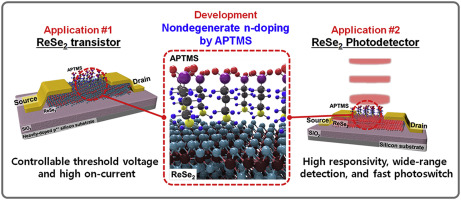Organic Electronics ( IF 2.7 ) Pub Date : 2017-11-06 , DOI: 10.1016/j.orgel.2017.11.006 Muhammad Hasnain Ali , Dong-Ho Kang , Jin-Hong Park

|
Rhenium diselenide (ReSe2) has a small bandgap (<1 eV), which facilitates its longer wavelength photodetection capability. However, ReSe2-based photodetectors have presented relatively low photoresponsivity compared to devices fabricated on conventional transition metal dichalcogenides (TMDs), such as MoS2 and WSe2. Here, we demonstrate a high-performance ReSe2 near-infrared photodetector with high photoresponsivity (4.2 × 104 A/W), a wide detection range (520–1064 nm), and fast photoswitching time (τrise: 1.9 ms and τdecay: 4.5 ms). This was accomplished by an organic molecule-based n-doping technique based on a (3-aminopropyl)trimethoxysilane (APTMS). The n-doping concentration of ReSe2 was controlled between 7.82 × 1010 and 3.90 × 1011 cm−2, which lies in the nondegenerate regime. After the APTMS treatment, photoresponsivity values were increased from 4.3 × 103 to 4.2 × 104 A/W (tenfold at λ = 785 nm) and from 3.6 to 28.5 A/W (eightfold at λ = 1064 nm). The photoswitching times obtained after the n-type doping (τrise/τdecay: 1.9/4.5 ms) were also shorter than previously reported values in the devices formed on rhenium-based TMDs. We expect that this doping technique would be useful for the integration and performance optimization of various TMD-based devices in the future.
中文翻译:

(3-氨基丙基)三甲氧基硅烷(APTMS)处理增强了二硒化((ReSe 2)红外光电探测器
二硒化((ReSe 2)具有小的带隙(<1 eV),这有利于其更长的波长光检测能力。然而,与在诸如MoS 2和WSe 2的传统过渡金属二卤化金属(TMD)上制造的器件相比,基于ReSe 2的光电探测器呈现出相对较低的光响应性。在这里,我们展示了一种高性能的ReSe 2近红外光电探测器,该探测器具有高光敏度(4.2×10 4 A / W),宽广的检测范围(520–1064 nm)和快速的光开关时间(τ上升:1.9 ms和τ)衰变:4.5毫秒)。这是通过基于有机分子的基于(3-氨丙基)三甲氧基硅烷(APTMS)的n掺杂技术完成的。ReSe 2的n掺杂浓度被控制在7.82×10 10和3.90×10 11 cm -2之间,处于非简并状态。在APTMS处理后,光敏度值从4.3×10 3增加到4.2×10 4 A / W(在λ= 785 nm时是十倍)和从3.6到28.5 A / W(在λ= 1064 nm时是八倍)。在n型掺杂之后获得的光开关时间(τ上升/τ衰减:1.9 / 4.5 ms)也比以前在reported基TMD上形成的器件中报告的值短。我们希望这种掺杂技术将来对各种基于TMD的设备的集成和性能优化有用。

































 京公网安备 11010802027423号
京公网安备 11010802027423号